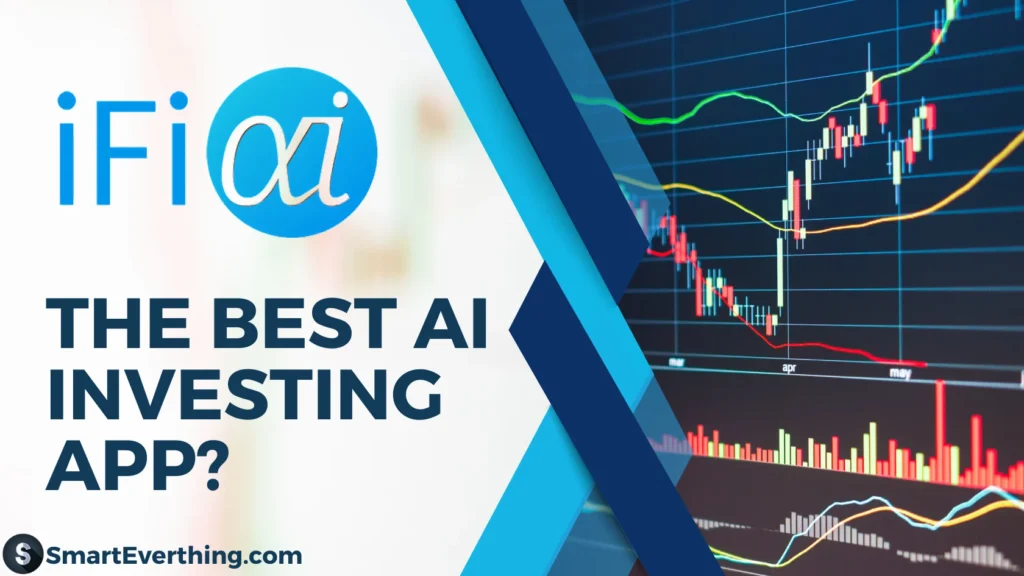AI 2.0 Stocks: Where Tech Meets Investment
The hype surrounding AI 2.0 is undeniable, with companies like Nvidia consistently showcasing its potential. However, before you rush to invest all your savings in the latest AI company, let’s take a step back and ensure we have a thorough understanding of the technology driving this excitement.
Recommended: iFi AI Review: Is This the Best AI Investing App?
Exploring the Tech Landscape of AI 2.0
Remember the old, clunky AI from the past? Forget it. AI 2.0 is all about flexibility, adaptation, and pushing the boundaries of what AI can do.
What is AI 2.0?
AI 2.0, also known as next-generation AI, is essentially an upgrade on traditional AI characterized by several key advancements:
Here are some of the key tech advancements defining this new era:
- Beyond Machine Learning: While machine learning is crucial for AI 2.0, it’s not the only tool. We’re seeing the rise of:
- Symbolic AI: Think logic and reasoning, letting AI understand and interpret situations, not just react to data patterns. Picture an AI lawyer making arguments or a robot chef figuring out a complex recipe.
- Neuromorphic computing: Inspired by the human brain, these chips promise efficiency and power for AI tasks. Imagine self-driving cars making quick decisions or medical AI analyzing huge datasets in real-time.
- Explainable AI (XAI): No more mysterious black boxes! XAI makes AI models transparent, helping us understand how they make decisions. This is important for building trust and avoiding bias in areas like healthcare or finance.
- See Also: Promise and Peril of Adaptive AI 2024: Unveiling Concerns & Ethical Dilemmas
- Embodied AI: Moving from Data Analysis to Real-World Interaction
AI 2.0 isn’t just about crunching numbers anymore. It’s about entering the physical world, interacting with it, and learning from it. Get ready for:
- Enhanced Perception: Robots with advanced sensors and computer vision aren’t blind anymore. Imagine robots moving through tricky places like construction sites or disaster zones with human-like skills.
- Dexterous Manipulation: Forget about clumsy industrial robots. AI 2.0 robots are developing fine motor skills, doing delicate tasks like putting together electronics or performing surgery. The future of manufacturing and healthcare just got a whole lot more interesting.
- Adaptive Learning: These robots aren’t just following instructions. They learn and adjust through experience, making them more versatile. Picture robots in factories adjusting to changes in production lines or search and rescue robots learning to move in new places.
- Generative AI: Creating the Future, One Pixel at a Time
AI 2.0 isn’t just about understanding the world; it’s about creatively shaping it. Get ready for:
- Natural Language Generation (NLG): Imagine AI writing news articles, creating marketing copy, or even composing personalized poems. The possibilities for content creation and communication are endless.
- Generative Adversarial Networks (GANs): These AI systems challenge each other, creating more realistic and creative outputs like images, music, or even 3D models. The future of art, design, and entertainment is wide open.
- Personalized Experiences: From customizing your news feed to tailoring shopping recommendations, AI 2.0 is learning to cater to your individual needs and preferences. Get ready for a world that feels truly made for you.
- Decentralized and Autonomous AI: Boosting Intelligence at the Edge
AI 2.0 isn’t just about giant supercomputers. It’s about spread-out intelligence, working together and independently:
- Federated Learning: Imagine training AI models on millions of devices without compromising privacy. This opens doors for personalized healthcare, smart cities, and more, all while protecting user data.
- Multi-agent Systems: Think teams of AI agents working together to solve tough problems. Imagine swarms of robots helping in disaster relief or AI systems working together to manage energy grids efficiently.
- Blockchain-based AI: By using the security and transparency of blockchain, AI 2.0 can be more trustworthy and accountable. Imagine secure and trackable AI applications in finance, supply chain management, and beyond.
- Human-AI Collaboration: A Team Effort
AI 2.0 isn’t about replacing humans; it’s about boosting our abilities. Here’s how:
- Human-in-the-Loop Systems: Important decisions stay in human hands, with AI providing insights and suggestions. Imagine doctors using AI-powered diagnostics while still having the final say in patient care.
- Augmented Intelligence: Think AI tools supercharging human abilities. Imagine engineers using AI-powered design tools or analysts using AI for deeper insights.
Navigating the AI 2.0 Stock Market: Chances and Risks
Now that we’ve dived into the mind-blowing tech behind AI 2.0, let’s talk about what this means for your investment portfolio. Exploring the chances and risks linked with AI 2.0 stocks.
Identifying Key Players: Chipmakers, Software Giants, and More
The AI 2.0 revolution isn’t happening alone. It’s fueled by different players across various sectors. Let’s meet some of the main movers and shakers:
Chipmakers: These folks provide the muscle for AI’s computational needs. Think:
- Nvidia (NVDA): The top dog in graphics processing units (GPUs), crucial for training and running AI models. Their stock has soared on the AI wave, but is it still a smart buy?
- Advanced Micro Devices (AMD): A strong competitor to Nvidia, AMD is also a major player in AI-focused chips. Their stock has seen impressive growth, but can they keep up with the competition?
Software Companies: They create the platforms and tools that power AI development and applications. Here are some big names:
- Microsoft (MSFT): This tech giant offers a vast cloud computing platform (Azure) with AI-powered services like Azure Cognitive Services. A safe bet due to its size and diverse offerings.
- Alphabet (GOOG): Google’s parent company is leading AI research with DeepMind, one of the world’s top AI labs. They’re also developing AI-powered products like Waymo self-driving cars. An exciting player, but with inherent volatility.
Other Industries: Don’t underestimate the diverse uses of AI 2.0. Keep an eye on:
- Tesla (TSLA): While not just about AI, Tesla heavily uses AI for self-driving technology and other features. Their stock is known for its ups and downs, but it offers high-risk, high-reward potential.
- Boston Dynamics: This company creates advanced robots, using AI to make them smarter and more capable. They’re still private, but a potential future IPO could be interesting.
Remember: This is just a starting point. Do your own research and diversify your portfolio before jumping in.
Looking at Investment Considerations: Risk and Reward in the AI Frontier
Investing in AI 2.0 stocks is exciting, but it’s not without challenges. Here’s what to consider:
- Understanding the Technology: Not all companies claiming to be “AI” are the same. Separate genuine innovation from marketing hype.
- Market Volatility: The AI sector is young and dynamic, leading to big price swings. Be ready for a rollercoaster ride.
- Long-Term Vision: Don’t expect quick riches. Invest with a long-term perspective, believing in the transformative power of AI 2.0.
- Data: Remember, data is what fuels AI. Companies with access to vast, high-quality data have a big advantage.
- Regulation: As AI evolves, so will regulations. Stay informed about potential changes that could impact specific companies or the sector as a whole.
- Ethical Considerations: Invest in companies committed to developing and using AI responsibly, addressing concerns like bias and transparency.
Building a Strong Portfolio: Diversification Strategies for AI Exposure
Don’t put all your eggs in one basket! Here are some smart ways to get exposure to AI 2.0 while managing risk:
- Select Across Sectors: Don’t limit yourself to chipmakers or software companies. Explore different applications like healthcare (e.g., Verily Life Sciences), finance (e.g., Upstart), or retail (e.g., Amazon).
- Balance Established Players with Emerging Disruptors: Mix big, established companies with promising startups to get stability and potential for high growth.
- Integrate AI Stocks with a Well-Diversified Portfolio: Don’t forget the basics! Allocate a part of your portfolio to AI, but keep a balanced mix of asset classes and risk levels.
Remember: Diversification is important to reduce risk and maximize returns in any market, especially one as dynamic as AI 2.0.
Case Studies & Expert Insights: Unraveling AI 2.0 Investment Opportunities
The world of AI 2.0 stocks is full of promising players and complex considerations. But don’t worry, we’re not leaving you hanging! In this section, we’ll dive into real-world case studies, data-driven insights, and expert opinions to light up the investment landscape and help you spot potential opportunities.
Case Study 1: Nvidia (NVDA) – The King of GPUs
Nvidia rules the GPU market, with its chips powering the training and execution of numerous AI models. Their stock has soared thanks to AI demand, but analysts debate its future potential. Let’s analyze:
- Pros: Dominant market position, strong finances, diverse revenue streams beyond gaming, continuous innovation in AI-focused hardware.
- Cons: High valuation, tough competition from AMD, and the potential for market saturation as AI technology evolves.
Expert Opinion: “While Nvidia is a leader today, the AI hardware landscape is dynamic. Keep an eye on emerging technologies and competitors before making a long-term investment.” – Dr. Jane Zhang, AI Hardware Analyst, GigaOM Research.
Case Study 2: Alphabet (GOOG) – Betting on DeepMind’s AI Edge
Alphabet boasts DeepMind, one of the world’s top AI research labs, driving innovation across Google products like Waymo self-driving cars. But can their research turn into profitable investments?
- Pros: Cutting-edge research capabilities, vast data resources, diverse AI applications across Google products, and potential for breakthrough innovations.
- Cons: High research and development costs, the uncertain timeline for commercialization of DeepMind’s projects, volatile stock price due to broader market trends.
Expert Opinion: “Alphabet is a long-term play on the future of AI. Investors seeking immediate returns might be better off looking elsewhere, but for those with a patient outlook, Alphabet offers exciting potential.” Mr. John Lee, Portfolio Manager, AI Ventures Fund.
Data-Driven Insights:
A recent report by McKinsey Global Institute highlights that the global AI market could reach $5.8
trillion by 2025, with significant growth across various sectors. Additionally, a study by PwC reveals that 83% of CEOs worldwide believe AI will significantly impact their industries in the next five years.
Remember: These are just snapshots. conduct your own due diligence before making investment decisions.
Emerging Trends, Ethical Considerations, and Resources: Navigating the Future of AI 2.0 Investing
The AI 2.0 landscape is always changing, offering both exciting opportunities and complex challenges. To succeed in this dynamic environment, here are some important aspects to consider:
Emerging Trends to Watch:
- Edge AI: Processing power gets closer to data sources, making AI applications in areas like IoT and autonomous vehicles faster and more efficient.
- Federated Learning: Collaborative training across devices without sharing data, unlocking the power of decentralized datasets while addressing privacy concerns. Learn more about Federated Learning
- Explainable AI (XAI): Building trust and transparency in AI decision-making through interpretable models, crucial for ethical considerations and regulatory compliance.
- AI for Social Good: Addressing global challenges like climate change, poverty, and healthcare with responsible AI development and deployment.
Ethical Considerations for Responsible Investors:
- Bias and Fairness: Make sure the AI systems you invest in are developed and used in a fair and unbiased way, mitigating potential discrimination.
- Transparency and Explainability: Choose companies committed to building transparent and understandable AI models, fostering trust and accountability.
- Privacy and Security: Invest in companies prioritizing data privacy and security, especially as AI applications collect and analyze increasingly sensitive data.
- Environmental Impact: Be mindful of the energy consumption and potential environmental impact of large-scale AI models and computing infrastructure.
Suggested Resources for Investment Decisions:
- Industry Reports: McKinsey Global Institute, PwC, Gartner
- AI Research Labs: DeepMind, OpenAI, Stanford AI100
- Investment Firms: AI Ventures Fund, ARK Invest, Baillie Gifford
- News and Analysis: MIT Technology Review, The Information, VentureBeat
- Ethical AI Organizations: Partnership on AI, World Economic Forum Center for the Fourth Industrial Revolution, Berkman Klein Center for Internet & Society

Remember: Investing in AI 2.0 is a journey, not a destination. Stay informed, adapt to changing trends, and prioritize ethical considerations to make responsible and rewarding investment decisions in this transformative era.
This wraps up your deep dive into AI 2.0 stocks from both a technological and investment perspective. Keep learning, stay savvy, and make informed choices as you navigate the fascinating and ever-changing world of AI!


Appreciating the hard work you put into your blog and detailed information you present.
It’s great to come across a blog every once in a while that isn’t the same
old rehashed material. Great read! I’ve saved your site and I’m including your RSS feeds to my Google account.
website: writeit1 .com/
Thank you for your sharing. I am worried that I lack creative ideas. It is your article that makes me full of hope. Thank you. But, I have a question, can you help me?
Of course, I’m here to help with any questions you have. Feel free to ask away, and I’ll do my best to provide a helpful answer.